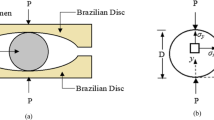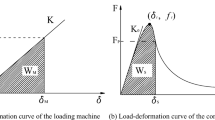Abstract
In this study, the surface and internal strain response of a specimen subjected to the nitrogen gas tension test was examined. The effect of the restraining force acting on the cylindrical specimen due to the rubber “O” ring seal was also determined. It was found that the effect of the restraining force was vanishingly small, and that the specimen was uniformly deformed in the axial direction. The effect of moisture content was also studied, and was found to have a considerable influence on the results. It was concluded that the concrete specimen should be considered as a two-phase system, consisting of a solid phase and a fluid phase.












Similar content being viewed by others
References
Clayton N, Grimer FJ (1979) The diphase concept, with particular reference to concrete. In: Lydon FD (ed) Developments in concrete technology—1. Applied Science Publishers LTD, UK, pp 283–318
Clayton N (1978) Fluid-pressure testing of concrete cylinders. Mag Concr Res 30(102):26–30
Boyd AJ, Mindess S (2001) The effect of sulfate attack on the tensile to compressive strength ratio of concrete. In: Banthia N, Sakai K, Gjørv OE (eds) Proceedings third international conference on concrete under severe conditions, vol 1. The University of British Columbia, Vancouver, Canada, pp 789–796
Mindess S, Young JF, Darwin D (2003) Concrete, 2nd edn. Prentice Hall, Upper Saddle River
Mindess S, Fujikake K, Xu H, Uno T (2005) The nitrogen gas tension test of concrete. In: Proceedings of 3rd international conference on construction materials and Mindess symposium, CD-Rom
Kupfer H, Hilsdorf H, Rusch H (1969) Behavior of concrete under biaxial stresses. ACI J Proc 66(8):656–666
Terzaghi K, Peck RB (1967) Soil mechanics in engineering practice, 2nd edn. Wiley, New York
Bazant ZP (1970) Constitutive equation for concrete creep and shrinkage based on thermodynamics of multiphase systems. Mater Struct 3(1):3–36
Gawin D, Pesavento F, Schrefler BA (2003) Modeling of hygro-thermal behaviour of concrete at high temperature with thermo-chemical and mechanical material degradation. Comput Methods Appl Mech Eng 192:1731–1771
Ulm FJ, Constantinides G, Heukamp FH (2004) Is concrete a poromechanics material? A multiscale investigation of poroelastic properties. Mater Struct 37:43–58
Benboudjema F, Meftah F, Torrenti JM (2005) Interaction between drying, shrinkage, creep and cracking phenomena in concrete. Eng Struct 27:239–250
Author information
Authors and Affiliations
Corresponding author
Rights and permissions
About this article
Cite this article
Uno, T., Fujikake, K., Mindess, S. et al. The nitrogen gas tension test of concrete. Part 1: effect of boundary conditions and axial strain response. Mater Struct 44, 857–864 (2011). https://doi.org/10.1617/s11527-010-9672-y
Received:
Accepted:
Published:
Issue Date:
DOI: https://doi.org/10.1617/s11527-010-9672-y




